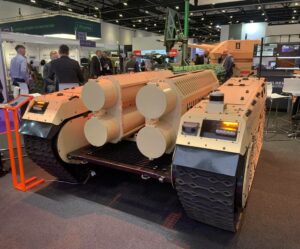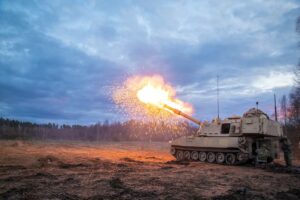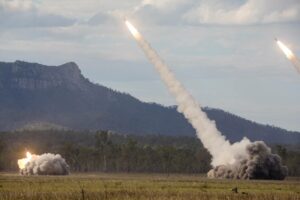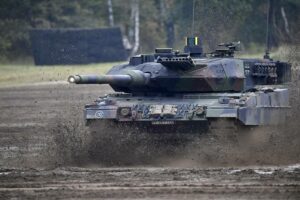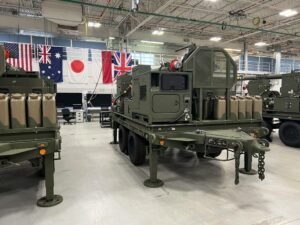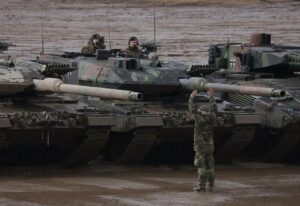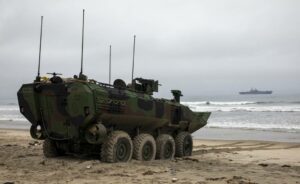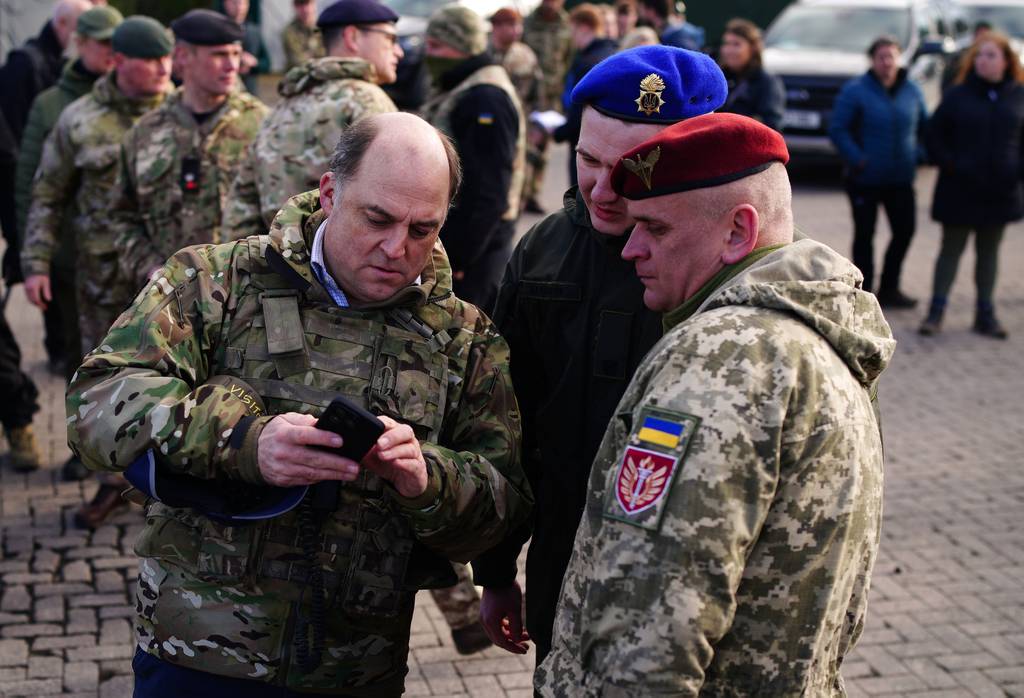
MILAN and COLOGNE, Germany — The debate over U.S. cluster munition deliveries to Ukraine has ignited a fresh look in the British military at a capability that has faded along with their banning: the destruction of enemy airfields.
That is according to the U.K. Defence Minister Ben Wallace, who was speaking at a side event of the NATO summit in Vilnius, Lithuania, on July 12.
Wallace said he wants British industry to come up with an alternative to achieve the same destructive effects, albeit without the danger of unexploded ordnance left behind by the types of submunition-laden shells that the United States is giving to Ukraine.
“One challenge to our industry is, we see the Ukrainians struggle to shut down runways,” he said at the NATO Public Forum, an event organized by a smattering of think tanks from both sides of the Atlantic. “So what I have got in my weapons stock, should we find ourselves in a conflict where I need to do this? It goes back to: If you can’t use cluster munitions, you need to innovate and come up with something else,” Wallace said.
An international convention bans the production, use and transfer of cluster munitions because of the risks they pose to civilians even long after wars end. The United States and Ukraine are not a signatory to that treaty, and neither is Russia, whose forces have reportedly clusters munitions “and even worse,” as Dutch Defense Minister Kajsa Ollongren, who was speaking alongside Wallace at the event in Vilnius, put it.
There is a history of militaries developing munitions, mostly in the 1970s, specifically aimed at damaging enemy runways so comprehensively that any repairs would take a long time. Such strikes would effectively keep valuable adversary warplanes off the battlefield, the thinking went.
British forces used to have the so-called JP233 submunition dispensing pods, for example, notes Mark Cancian, an analyst at the Washington-based Center for Strategic and International Studies. Strapped under warplanes, the weapons were designed to blanket runways with hundreds of exploding bomblets.
A French-designed weapon, the Durandal, consisted of a warhead plowing underneath the tarmac to deliver a series of explosions aimed mangling a runway’s foundation, according to Cancian.
Defense experts believe there are several methods today that could deliver a wider area of destructive coverage without the design constraints of cluster munitions: the saturation of target areas with conventional, air-burst munitions, or by sending swarms of cheap drones.
“A swarm of 1,000 mini drone-copters could cover a very large area, especially if launched via a GMLRS rocket,” said Nicholas Drummond, an adviser to Krauss-Maffei Wegmann in the U.K., referring to the Guided Multiple Launch Rocket System.
Elisabeth Gosselin-Malo is a Europe correspondent for Defense News. She covers a wide range of topics related to military procurement and international security, and specializes in reporting on the aviation sector. She is based in Milan, Italy.
Sebastian Sprenger is associate editor for Europe at Defense News, reporting on the state of the defense market in the region, and on U.S.-Europe cooperation and multi-national investments in defense and global security. Previously he served as managing editor for Defense News. He is based in Cologne, Germany.
- SEO Powered Content & PR Distribution. Get Amplified Today.
- PlatoData.Network Vertical Generative Ai. Empower Yourself. Access Here.
- PlatoAiStream. Web3 Intelligence. Knowledge Amplified. Access Here.
- PlatoESG. Automotive / EVs, Carbon, CleanTech, Energy, Environment, Solar, Waste Management. Access Here.
- BlockOffsets. Modernizing Environmental Offset Ownership. Access Here.
- Source: https://www.defensenews.com/global/europe/2023/07/13/uk-defense-chief-muses-about-replicating-cluster-munitions-edge/
- :has
- :is
- :not
- :where
- $UP
- 000
- 1
- 12
- 17
- 70
- a
- About
- According
- Achieve
- After
- aimed
- along
- alongside
- alternative
- an
- analyst
- and
- any
- ARE
- AREA
- areas
- AS
- Associate
- At
- aviation
- back
- Bans
- based
- Battlefield
- because
- behind
- believe
- ben
- both
- Both Sides
- British
- by
- capability
- Center
- challenge
- cheap
- chief
- civilians
- Cluster
- Cologne
- come
- conflict
- constraints
- Convention
- conventional
- cooperation
- could
- cover
- coverage
- covers
- damaging
- DANGER
- debate
- defence
- Defense
- deliver
- Deliveries
- Design
- designed
- developing
- do
- down
- Drones
- Dutch
- Edge
- editor
- effectively
- effects
- else
- end
- especially
- Europe
- Even
- Event
- example
- experts
- experts believe
- explosions
- Find
- For
- Forces
- Forum
- Foundation
- fresh
- from
- Germany
- Global
- Goes
- Have
- he
- history
- HTTPS
- Hundreds
- i
- if
- images
- in
- industry
- innovate
- International
- Investments
- IT
- Italy
- jpg
- July
- Keep
- large
- launch
- launched
- left
- Lithuania
- Long
- long time
- Look
- managing
- mark
- Market
- methods
- MILAN
- militaries
- Military
- mostly
- multi-national
- multiple
- my
- Need
- Neither
- news
- Notes
- of
- off
- on
- or
- Organized
- our
- ourselves
- over
- plato
- Plato Data Intelligence
- PlatoData
- pods
- previously
- procurement
- Production
- public
- put
- range
- region
- related
- Reporting
- risks
- rocket
- Russia
- s
- Said
- same
- sector
- security
- see
- sending
- Series
- several
- she
- should
- Shut down
- side
- Sides
- signatory
- So
- something
- speaking
- specializes
- specifically
- State
- States
- stock
- Strategic
- Strikes
- Struggle
- studies
- such
- Swarm
- system
- Take
- Tanks
- Target
- that
- The
- The State
- their
- There.
- they
- think
- Thinking
- this
- time
- to
- today
- Topics
- transfer
- types
- U.K.
- u.s.
- Uk
- Ukraine
- Ukrainians
- under
- United
- United States
- use
- used
- Valuable
- very
- via
- wants
- Warplanes
- was
- we
- Weapons
- went
- were
- What
- WHO
- whose
- wide
- Wide range
- wider
- with
- without
- worse
- would
- you
- zephyrnet


